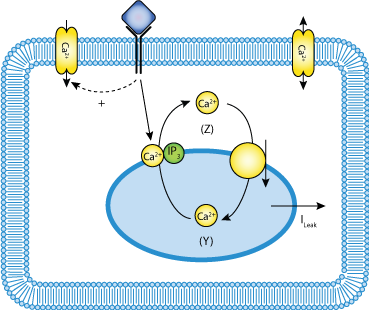
This CellML model runs in OpenCell and COR to reproduce published results. The a model is based on equations 1, 2a ,3 and 4a (Figure 8). The b model is based on equations 1, 2b, 3 and 4b (Figure 3)
Experimental observations indicate that Ca(2+)-induced Ca2+ release (CICR) may underlie Ca2+ oscillations in a variety of cells. In its original version, a theoretical model for signal-induced Ca2+ oscillations based on CICR assumed the existence of two types of pools, one sensitive to inositol 1,4,5-trisphosphate (IP3) and the other one sensitive to Ca2+. Recent experiments indicate that Ca2+ channels may sometimes be sensitive to both IP3 and Ca2+. Such a regulation may be viewed as Ca(2+)-sensitized IP3-induced Ca2+ release or, alternatively, as a form of IP3-sensitized CICR. We show that sustained oscillations can still occur in a one-pool model, provided that the same Ca2+ channels are sensitive to both Ca2+ and IP3 behaving as co-agonists. This model and the two-pool model based on CICR both account for a number of experimental observations but differ in some respects. Thus, while in the two-pool model the latency and period of Ca2+ oscillations are of the same order of magnitude and correlate in a roughly linear manner, latency in the one-pool model is always brief and remains much shorter than the period of oscillations. Moreover, the first Ca2+ spike is much larger than the following ones in the one-pool model. These distinctive properties might provide an explanation for the differences in Ca2+ oscillations observed in various cell types.
The original paper reference is cited below:
'One-pool model for Ca2+ oscillations involving Ca2+ and inositol 1,4,5-trisphosphate as co-agonists for Ca2+ release', Dupont, G. and Goldbeter, A., 1993 Cell Calcium, 14(4), 311-322. PubMed ID: 8370067

|
| Schematic diagram depicting the Dupont and Golbeter model |